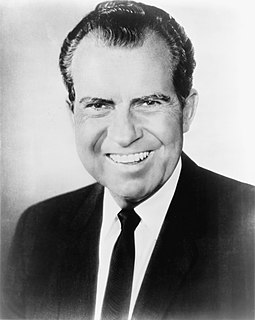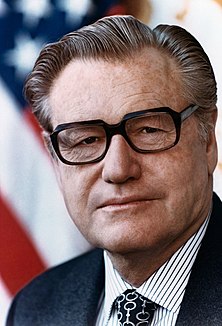
The 1956 United States presidential election was the 43rd quadrennial presidential election. It was held on Tuesday, November 6, 1956. President Dwight D. Eisenhower successfully ran for reelection against Adlai Stevenson II, the former Illinois governor whom he had defeated four years earlier.

The 1964 United States presidential election was the 45th quadrennial presidential election. It was held on Tuesday, November 3, 1964. Incumbent Democratic United States President Lyndon B. Johnson defeated Barry Goldwater, the Republican nominee, in a landslide. With 61.1% of the popular vote, Johnson won the largest share of the popular vote of any candidate since the largely uncontested 1820 election.

The 1968 United States presidential election was the 46th quadrennial presidential election, held on Tuesday, November 5, 1968. The Republican nominee, former vice president Richard Nixon, defeated the Democratic nominee, incumbent vice president Hubert Humphrey, and the American Independent Party nominee, former Alabama Governor George Wallace.

The Rockefeller Republicans were members of the Republican Party (GOP) in the 1930s–1970s who held moderate-to-liberal views on domestic issues, similar to those of Nelson Rockefeller, Governor of New York (1959–1973) and Vice President of the United States (1974–1977). Rockefeller Republicans were most common in the Northeast and industrial Midwestern states, with their larger moderate-to-liberal constituencies, while they were rare in the South and West.

Gerald Ford's tenure as the 38th president of the United States began on August 9, 1974, upon the resignation of Richard Nixon from office, and ended on January 20, 1977, a period of 895 days. Ford, a Republican from Michigan, had served as vice president since December 6, 1973, following Spiro Agnew's resignation from that office. Ford has the distinction of being the only person to serve as president without being elected to either the presidency or the vice presidency. His presidency ended following his defeat in the 1976 presidential election by Democrat Jimmy Carter.

The 2004 Republican National Convention took place from August 30 to September 2, 2004 at Madison Square Garden in New York City, New York. The convention is one of a series of historic quadrennial meetings at which the Republican candidates for president and vice president, and party platform are formally adopted. Attendance included 2,509 delegates and 2,344 alternate delegates from the states, territories and the District of Columbia. The convention marked the formal end of the active primary election season. As of 2021, it is the most recent major-party nominating convention to be held in New York City.

John Lester Hubbard Chafee was an American politician and officer in the United States Marine Corps. A member of the Republican Party, he served as the 66th Governor of Rhode Island, as the Secretary of the Navy, and as a United States Senator.
The 1964 Republican National Convention took place in the Cow Palace, Daly City, California, from July 13 to July 16, 1964. Before 1964, there had been only one national Republican convention on the West Coast, the 1956 Republican National Convention, which also took place in the Cow Palace. Many believed that a convention at San Francisco indicated the rising power of the Republican Party in the west.

The 1968 Republican National Convention was held at the Miami Beach Convention Center in Miami Beach, Dade County, Florida, from August 5 to August 8, 1968, to select the party's nominee in the general election. It nominated former Vice President Richard M. Nixon for president and Maryland Governor Spiro T. Agnew for vice president. It was the fourth time Nixon had been nominated on the Republican ticket as either its vice presidential or presidential candidate (1960).

Richard Art Viguerie is an American conservative figure, pioneer of political direct mail and writer on politics. He is the current chairman of ConservativeHQ.com.

The 1960 Republican National Convention was held in Chicago, Illinois, from July 25 to July 28, 1960, at the International Amphitheatre. It was the 14th and most recent time overall that Chicago hosted the Republican National Convention, more times than any other city.

Dwight D. Eisenhower's tenure as the 34th president of the United States began with his first inauguration on January 20, 1953, and ended on January 20, 1961. Eisenhower, a Republican from Kansas, took office following a landslide victory over Democrat Adlai Stevenson in the 1952 presidential election. John F. Kennedy succeeded him after winning the 1960 presidential election.
Dorothy Andrews Elston Kabis was a Republican Party activist from the U.S. state of Delaware who was appointed the 33rd Treasurer of the United States, having served from May 8, 1969, until her death. She was the only Treasurer to marry while in office.

From August 16 to August 19, 1976, voters of the Republican Party chose its nominee for president in the 1976 United States presidential election. The major candidates were incumbent President Gerald Ford and former Governor of California Ronald Reagan. After a series of primary elections and caucuses, neither secured a majority of the delegates before the convention.
The 1964 presidential campaign of Barry Goldwater began when United States Senator Barry Goldwater of Arizona elected to seek the Republican Party nomination for President of the United States to challenge incumbent Democratic President Lyndon B. Johnson. Early on, before officially announcing his candidacy for the presidency, Goldwater was accused by Governor of New York Nelson Rockefeller of attempting to galvanize Southern and Western Republican support while neglecting the industrial northern states, eventually becoming one of Goldwater's primary opponents in the race for the Republican Party's nomination in 1964.

From March 10 to June 2, 1964, voters of the Republican Party chose its nominee for president in the 1964 United States presidential election. Senator Barry Goldwater of Arizona was selected as the nominee through a series of primary elections and caucuses culminating in the 1964 Republican National Convention held from July 13 to July 16, 1964, in San Francisco, California.

From March 12 to June 11, 1968, voters of the Republican Party chose its nominee for president in the 1968 United States presidential election. Former vice president Richard Nixon was selected as the nominee through a series of primary elections and caucuses culminating in the 1968 Republican National Convention held from August 5 to August 8, 1968, in Miami Beach, Florida.

Nelson Aldrich Rockefeller, sometimes referred to by his nickname Rocky, was an American businessman and politician who served as the 41st vice president of the United States from December 1974 to January 1977, and previously as the 49th governor of New York from 1959 to 1973. He also served as assistant secretary of State for American Republic Affairs for Presidents Franklin D. Roosevelt and Harry S. Truman (1944–1945) as well as under secretary of Health, Education and Welfare (HEW) under Dwight D. Eisenhower from 1953 to 1954. In 1980, HEW split into 2 cabinet level agencies: Health & Human Services (HHS) & Department of Education. A grandson of Standard Oil founder John D. Rockefeller and a member of the wealthy Rockefeller family, he was a noted art collector and served as administrator of Rockefeller Center in Manhattan, New York City.

The 1968 presidential campaign of Richard Nixon, the 36th Vice President of the United States, began when Nixon, the Republican nominee of 1960, formally announced his candidacy, following a year's preparation and five years' political reorganization after defeats in the 1960 presidential election and the 1962 California gubernatorial election.
This article lists those who were potential candidates for the Republican nomination for Vice President of the United States in the 1968 election. After winning the Republican presidential nomination at the 1968 Republican National Convention, former Vice President Richard Nixon convened a series of meetings with close advisers and party leaders such as Strom Thurmond in order to choose his running mate. Nixon ultimately asked the convention to nominate Maryland Governor Spiro Agnew as his running mate. By a large margin, Agnew won the vice presidential nomination on the first ballot over Michigan Governor George W. Romney, who was supported by a faction of liberal Republicans. Nixon chose Agnew because he wanted a centrist who was broadly acceptable to the party, had experience with domestic issues, and appealed to Southern voters. The Nixon–Agnew ticket defeated the Humphrey–Muskie ticket, and also won re-election in 1972, defeating the McGovern–Shriver ticket. However, Agnew was forced to resign as Vice President in 1973 due to a controversy regarding his personal taxes.













